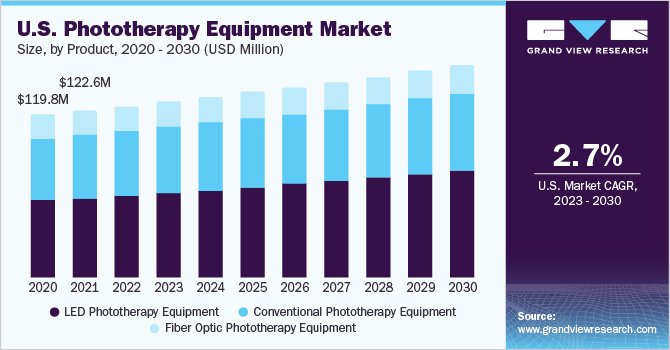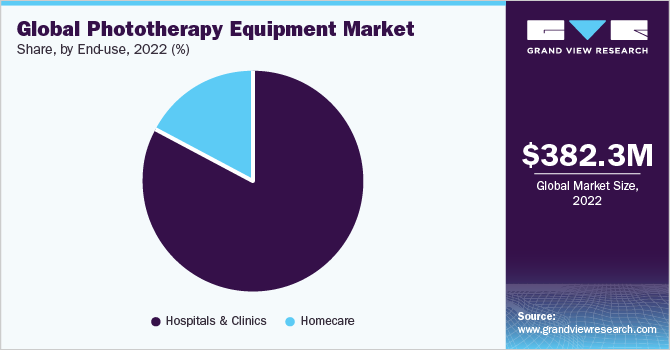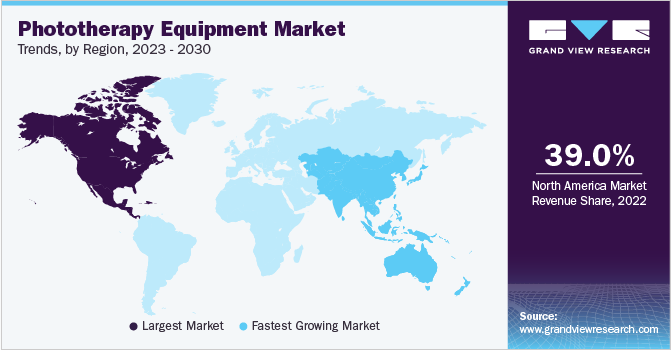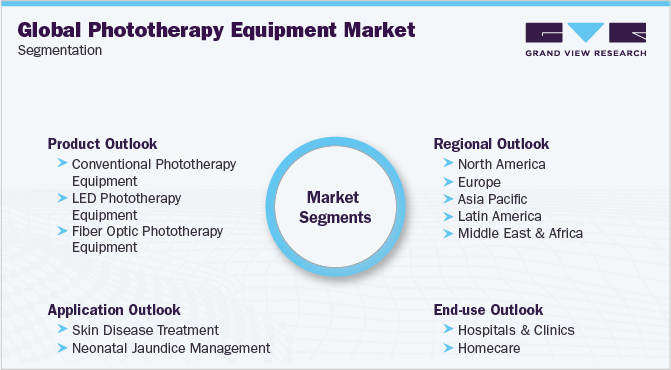
Phototherapy Equipment Market Size, Share & Trends Analysis Report By Product (Conventional Phototherapy Equipment), By Application (Skin Diseases Treatment, Neonatal Jaundice Management), By End-use, And Segment Forecasts, 2022 - 2030
- Report ID: GVR-1-68038-701-8
- Number of Pages: 90
- Format: Electronic (PDF)
- Historical Range: 2018 - 2020
- Industry:Healthcare
Report Overview
The global phototherapy equipment market size was valued at USD 368.8 million in 2021 and is anticipated to witness a compound annual growth rate (CAGR) of 3.95% during the forecast period. The rising prevalence of skin diseases is the key factor driving the market growth. For instance, according to the latest available data from the American Academy of Dermatology Association, 84.5 million Americans, i.e., around one in every four, are impacted by some kind of skin disease.

Moreover, as per National Psoriasis Foundation, around 125 million people globally, which is around 2-3% of the total population, suffer from psoriasis. Similarly, according to the National Eczema Association, around 31.6 million people in the U.S. suffer from eczema. Additionally, as per a similar source, one in every ten individuals is anticipated to suffer from eczema once in their lifetime. The percentage of people from different races who suffer from eczema is shown below:
White |
11% |
African American/black |
10% |
Asia or Pacific Islander |
13% |
Native American |
13% |
Phototherapy treatment is also very useful for treating neonatal jaundice. In this treatment, the neonates are exposed to fluorescent light, which helps them recover at a faster rate. The occurrence of jaundice among newborns is common; however, if it persists for long, then doctors use phototherapy devices for treatment. As per a Pediatric Medicine Journal, the incidence of jaundice in newborns has been reported to be between 60% to more than 90%. Similarly, according to the National Health Service, it is estimated that six in every ten babies develop jaundice, whereas eight out of ten babies born prematurely are at risk of suffering from jaundice.
Additionally, with the rising newborn population, the demand for phototherapy equipment devices is anticipated to impel. For instance, as per the Centers for Disease Control and Prevention, the number of births in 2021 increased in the U.S. for the first time in the past seven years. The report shows that there was a 1% rise in births in 2021, with 3,659,289 births. Thus, this is expected to help the market grow during the forecast period.
This device has proved to be more energy-efficient, which lasts 10 times longer than the conventional devices, and is also comparatively cheaper. Research done by Stanford Medical Schools, one of the partners of D-Rev, has proved its efficient application in the treatment of jaundice therapy. Most phototherapy devices use compact fluorescent bulbs due to their uniformity and ease of use.
The COVID-19 pandemic had a slightly negative impact on the phototherapy equipment market. However, with various strategic initiatives taken up by market players, the phototherapy equipment market is estimated to progress in the post-COVID-19 pandemic period. Market players are involved in initiatives such as product launches, geographic expansions, and mergers & acquisitions. For instance, in December 2020, GlobalMed Technologies launched a home use product ‘Omnilux Contour’. Additionally, the company launched a new online store for all its products, which was expected to help the company gain some market share during and after the COVID-19 pandemic.
Product Insights
LED光疗设备主导产品egment with a market share of 48.2% in the year 2021. LED-based phototherapy is used to treat skin diseases and concerns such as fine lines, psoriasis, and acne. The rise in the number of people suffering from such skin conditions is expected to impel the use of LED-based phototherapy devices. For instance, according to MDALGORITHMS INC., 85% of people experience acne at some point in their life. Moreover, as per a similar source, 50 million people in the U.S. are anticipated to suffer from acne, out of which 15% of them suffer from acne which can result in scarring.
Additionally, research has shown that infrared light therapy can improve and reduce fine lines & wrinkles. The increasing number of people suffering from fine lines & wrinkles is expected to help the segment propel. For instance, according to Pushups, LLC, as a result of wrinkles and other skin-related issues, around 60% of Americans do not feel comfortable regarding their own skin. This may increase the use of LED-based phototherapy equipment, thereby impelling the segment growth in the forecast period.
The conventional phototherapy equipment segment is anticipated to advance at a considerable growth rate of 3.51% during the forecast duration. Conventional phototherapy equipment is used for the treatment of jaundice, as it helps in reducing bilirubin levels in neonates. The rising incidence of newborns suffering from jaundice is anticipated to help the segment propel during the forecast period. For instance, according to the March of Dimes Organization, around 3 in every 5 babies (around 60%) suffer from jaundice. Similarly, according to Medscape, it is estimated that 80% of pre-term babies are expected to develop jaundice within 2-4 days. Therefore, the increasing number of pre-term babies is further expected to help the segment's growth.
Application Insights
皮肤疾病应用程序段为主market with a share of 67.5% in 2021. This can be accredited to a rise in the number of various skin diseases such as acne, vitiligo, and others. For instance, according to the British Journal of Dermatology, it is estimated that there were 117.4 million incident cases and 231.2 million prevalent cases of acne in 2019, which is around a 48% increase when compared with the statistics from 1990.
Similarly, vitiligo, a condition in which the skin loses its pigment cells, is becoming dormant in various regions globally. For instance, according to ResearchGate, India is predicted to have an incidence rate of 8.8%, whereas, the same for Mexico was estimated to be 2.6 - 4%. As phototherapy has shown to stop/slow down the progression of vitiligo, its use is expected to increase. Hence, due to the above-mentioned factors, the phototherapy equipment market is estimated to expand during the projected period.
Neonatal jaundice management is projected to witness a significant CAGR of 4.49% during the forecast years. This can be attributed to the increasing infant population and rising incidences of neonatal jaundice globally. For instance, as per an article by BMJ Publishing Group & Royal College of Paediatrics and Child Health, neonatal jaundice is extremely common in the U.K., where phototherapy is used to treat around 5-10% of babies born at term. The incidence rate of neonatal jaundice in East Asian and Asian/White infants relative to white infants is shown below:
Percentage |
No. of Infants |
No. (%) with Jaundice |
Relative risk to an infant of a white mother/father |
White mother/white father |
3,000 |
221 (7.4) |
1.00 |
Asian mother/white father |
2,997 |
240 (8.0) |
1.09 |
White mother/Asian father |
2,048 |
190 (9.3) |
1.26 |
Asian mother/Asian father |
3,000 |
303 (10.1) |
1.37 |
薄th Chinese |
1,095 |
101 (9.2) |
1.25 |
薄th Japanese |
279 |
38 (13.7) |
1.85 |
薄th Filipino |
1,483 |
146 (9.8) |
1.34 |
Mixed Asian |
143 |
18 (12.6) |
1.26 |
Moreover, there has been an increase in the number of births across the globe. For instance, according to Statistics Norway's quarterly population figure, in the first three months of 2021, 13,700 children were born, which was 700 more than what was observed in the first quarter of 2020. Therefore, as a result of the aforementioned factors, the segment is expected to witness a significant growth rate.
End-use Insights
Hospitals dominated the end-use segment with a market share of 82.9% in 2021. This can be attributed to the increasing number of hospitals worldwide. For instance, according to statistics by The King’s Fund Organization, the total number of hospitals in England tallied up to 141,000 in 2019/20. Similarly, as per data released by the American Health Association, the number of hospitals in the U.S. are as follows:
Total Number of All U.S. Hospitals |
6,093 |
Number of U.S. Community Hospitals |
5139年 |
Number of Nongovernment Not-for-Profit Community Hospitals |
2,960 |
Number of Investor-Owned (For-Profit) Community Hospitals |
1,228 |
Number of State and Local Government Community Hospitals |
951 |
Number of Federal Government Hospitals |
207 |
Number of Nonfederal Psychiatric Hospitals |
635 |
Other Hospitals |
112 |
Moreover, as per a study conducted by NCBI, the prevalence of neonatal jaundice at a National District Hospital, Bloemfontein, was calculated to be 55.2%. Hence, owing to the aforementioned factors, the segment is anticipated to propel during the forecast period.

然而,家庭护理段预计impel at the fastest CAGR of 5.09% in the forecast years. This can be credited to the availability of phototherapy equipment for homecare settings, and rising awareness about phototherapy equipment among the common population. Moreover, as per the National Psoriasis Foundation, treatment of psoriasis with a home UVB phototherapy can be convenient and economical. Similarly, according to The Royal Women’s Hospital, Australia, phototherapy is safe & convenient option to treat neonatal jaundice in a homecare setting. Hence, the segment is projected to experience lucrative growth in the forecast duration.
Regional Insights
North America dominated the phototherapy equipment market with a revenue share of 39.3% in 2021. The rising number of various skin conditions such as vitiligo, psoriasis, eczema, and acne is expected to help the region dominate the phototherapy equipment market. For instance, according to the Canadian Dermatology Association, acne affects around 5.6 million people in Canada, i.e., 20% of the total population suffers from acne. Similarly, as per the latest estimates by Atopic Dermatitis in America, around 7.3% of U.S. adults suffer from eczema, while around 40% of the people suffer from moderate to severe symptoms.

However, the Asia-Pacific region is projected to witness the fastest growth rate of 5.55% during the forecast period. The increase in the number of births of pre-term babies and a number of people suffering from skin disorders can be accredited to the high growth rate. For instance, as per The Lancet, around 85% of preterm births occur in the late preterm period, out of which 80% occur in Asia & South-Asian regions. Moreover, according to Narayan Health Organization, out of the 15 million pre-term births globally, 1/5thof these births take place in India alone. Additionally, people in the Asia Pacific are prone to acne, which is further expected to propel the use of phototherapy equipment. For instance, according to the Derma Health Institute, acne is a common condition for people of Asian ethnicity, thereby impelling the phototherapy equipment market in this region.
Key Companies & Market Share Insights
The phototherapy equipment market comprises several small and large manufacturers. The degree of competition and competitive rivalry in the market is anticipated to intensify in the forecast period. Major companies are focusing on clinical trials, mergers and acquisitions, product launches, and geographic expansions to have a competitive edge over others. For instance, a clinical trial is being conducted on BUBOLight, a new phototherapy device for the treatment of newborn babies’ jaundice. The aim of this study is to evaluate the satisfaction level and safety of the device. Thus, with various strategies acquired by market players, the phototherapy equipment market is expected to impel during the forecast period. Some prominent players in the phototherapy equipment market include:
Philips Lighting Holding B.V (Signify Holdings)
GE Healthcare
Natus Medical Incorporated
Hebert Waldmann GmbH & Co. KG
Nice Neotech Medical Systems Pvt. Ltd.
Phoenix Medical Systems Pvt. Ltd.
Atom Medical Corporation
National Biological Corp.
Solarc Systems Inc.
The Daavlin Company
Phototherapy Equipment Market Report Scope
Report Attribute |
Details |
Market size value in 2022 |
USD 382.3 million |
Revenue forecast in 2030 |
USD 521.1 million |
Growth rate |
CAGR of 3.95% from 2022 to 2030 |
Base year for estimation |
2021 |
Historical data |
2018 - 2020 |
Forecast period |
2022 - 2030 |
Quantitative units |
Revenue in USD million and CAGR from 2022 to 2030 |
Report coverage |
Revenue forecast, company ranking, competitive landscape, growth factors, and trends |
Segments covered |
Product, application, end-use, region |
Regional scope |
North America; Europe; Asia Pacific; Latin America; Middle East & Africa |
Country scope |
U.S.; Canada; U.K.; Germany; France; Italy; Spain; Japan; China; India; Australia; South Korea; Brazil; Mexico; Argentina; Colombia; South Africa; Saudi Arabia; UAE |
Key companies profiled |
Philips Lighting Holding B.V (Signify Holdings); GE Healthcare; Natus Medical Incorporated; Hebert Waldmann GmbH & Co. KG; Nice Neotech Medical Systems Pvt. Ltd.; Phoenix Medical Systems Pvt. Ltd.; Atom Medical Corporation; National Biological Corp.; Solarc Systems, Inc.; The Daavlin Company |
Customization scope |
Free report customization (equivalent up to 8 analysts working days) with purchase. Addition or alteration to country, regional & segment scope. |
价格和购买该俱乐部ns |
Avail customized purchase options to meet your exact research needs.Explore purchase options |
Global Phototherapy EquipmentMarket Segmentation
This report forecasts revenue growth at the global, regional, and country levels and provides an analysis of the latest industry trends in each of the sub-segments from 2018 to 2030. For this study, Grand View Research has segmented the global phototherapy equipment market report based on product, application, end-use, and region:

Product Outlook (Revenue, USD Million, 2018 - 2030)
Conventional Phototherapy Equipment
Conventional Phototherapy Equipment With Fluorescent Lamp
Conventional Phototherapy Equipment With Compact Fluorescent Lamp
LED Phototherapy Equipment
Fiber Optic Phototherapy Equipment
Application Outlook (Revenue, USD Million, 2018 - 2030)
Skin Disease Treatment
Psoriasis
Vitiligo
Eczema
Others
Neonatal Jaundice Management
End-use Outlook (Revenue, USD Million, 2018 - 2030)
Hospitals & Clinics
Homecare
Regional Outlook (Revenue, USD Million, 2018 - 2030)
North America
U.S.
Canada
Europe
U.K.
Germany
France
Italy
Spain
Asia Pacific
Japan
China
India
Australia
South Korea
Latin America
Brazil
Mexico
Argentina
哥伦比亚
Middle East & Africa
South Africa
Saudi Arabia
UAE
Frequently Asked Questions About This Report
b.The global phototherapy equipment market size was estimated at USD 368.8 million in 2021 and is expected to reach USD 382.3 million in 2022.
b.The global phototherapy equipment market is expected to grow at a compound annual growth rate of 3.95% from 2022 to 2030 to reach USD 521.1 million by 2030.
b.North America dominated the phototherapy equipment market with a share of 39.3% in 2021. This is attributable to the rising prevalence of acne-related problems and the huge adoption rate for technologically advanced skin care treatment devices.
b.Some of the key players operating in the phototherapy equipment market include Philips Lighting Holding B.V.; GE Healthcare; Natus Medical, Inc.; Herbert Waldmann GmbH & Co. KG; Nice Neotech Medical Systems Pvt. Ltd.; Phoenix Medical Systems Pvt. Ltd.; Atom Medical Corp.; National Biological Corp.; and Solarc Systems, Inc.
b.Key factors that are driving the phototherapy equipment market growth include the increasing prevalence of severe skin diseases, the introduction of technologically advanced products, and the rising prevalence of neonatal jaundice.





